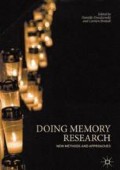Abstract
This chapter reorients traditional literary analysis toward interpreting and representing the spatial, social, and historical origins of texts informed by the legacy of the Venice Ghetto. Using ArcGIS Story Maps to create ‘thick’ digital maps, we emphasize the Ghetto’s layers of significance. This site-based approach to memory work is a close-reading of architectural space, infused with the affective traces of the past and present. Our interactive maps make our reading practices visible and engage the multidirectional movement of the historical, literary, and contemporary memories of ghetto spaces through what we term a process of reading-in-place; we visually represent the trauma, nostalgia, memorials, and histories that are encoded on the pages of literary narratives.
Access this chapter
Tax calculation will be finalised at checkout
Purchases are for personal use only
Notes
- 1.
As Bassi and di Leonardo explain, the word ‘ghetto’ comes from this site: ‘Those features that distinguished the Venetian case became the model for all subsequent ghettos, beginning with the name itself which derives from the Venetian geto (“the shape made in the mould when casting metal” according to G. Boerio’s classic Venetian dictionary). In the fifteenth century “terren del geto” meant an area of the public foundry for casting ordnance’ (2013, 10).
References
Agosín, M. (2004). Cartographies: Meditations on travel (N. Abraham Hall, Trans.). Athens: University of Georgia Press.
Bassi, S., & di Lenardo, I. (2013). The ghetto inside out (J. Francis Phillimore, Trans.). Venice: Corte del Fondego.
Benjamin, W. (1968). Theses on the philosophy of history. In H. Zohn (Trans.), Illuminations (pp. 253–264). New York: Schocken Books.
Degen, M., & Rose, G. (2012). The sensory experiencing of urban design: The role of walking and perceptual memory. Urban Studies, 49(15), 3271–3287.
Drucker, J. (2015, October 1). Humanizing maps: An interview with Johanna Drucker. PCMagazine. https://www.pcmag.com/article2/0,2817,2492337,00.asp
Hirsch, M. (2014). Presidential Address 2014 – Connective Histories in Vulnerable Times. PMLA, 129(3), 330–348.
Huyssen, A. (2003). Present pasts: Urban palimpsests and the politics of memory. Stanford: Stanford University Press.
Laforest, D. (2009). On deep mapping & storytelling. Pipelines (website). http://edmontonpipelines.org/musings/on-deep-mapping-storytelling/. Accessed 30 Feb 2017.
Presner, T., Shepard, D., & Kawano, Y. (2014). HyperCities: Thick mapping in the digital humanities. Cambridge, MA: Harvard University Press.
Springett, S. (2015). Going deeper or flatter: Connecting deep mapping, flat ontologies, and the democratizing of knowledge. Humanities, 4(4), 623–636.
Wolifson, P. (2016). Encountering the night with mobile methods. Geographical Review, 106(2), 174–200.
Acknowledgments
The authors would like to thank UC Santa Cruz Emeritus Professor Murray Baumgarten, Shaul Bassi (founder of Beit Venezia: A Home for Jewish Culture), and all of the participants in our early career scholar workshop ‘The Ghetto of Venice: The Future of Memory in the Digital Age’ held in the space of the Venice Ghetto (July 2016) for inspiring, supporting, and adding to this dynamic conversation. You can learn more about our work and find links to our mapping projects at www.veniceghettocollaboration.com.
Funding
The authors gratefully acknowledge the financial support from Jewish Studies at the University of California, Santa Cruz; the Institute for Humanities Research at the University of California, Santa Cruz; Beit Venezia: A Home for Jewish Culture; and the Gladys Krieble Delmas Foundation to travel to Venice , Italy, to undertake the research for this chapter.
Author information
Authors and Affiliations
Editor information
Editors and Affiliations
Rights and permissions
Copyright information
© 2019 The Author(s)
About this chapter
Cite this chapter
Sharick, A.K., Smeltzer, E.G., Trostel, K.G. (2019). Reading-in-Place and Thick Mapping the Venice Ghetto at 500. In: Drozdzewski, D., Birdsall, C. (eds) Doing Memory Research. Palgrave Macmillan, Singapore. https://doi.org/10.1007/978-981-13-1411-7_7
Download citation
DOI: https://doi.org/10.1007/978-981-13-1411-7_7
Published:
Publisher Name: Palgrave Macmillan, Singapore
Print ISBN: 978-981-13-1410-0
Online ISBN: 978-981-13-1411-7
eBook Packages: Social SciencesSocial Sciences (R0)

